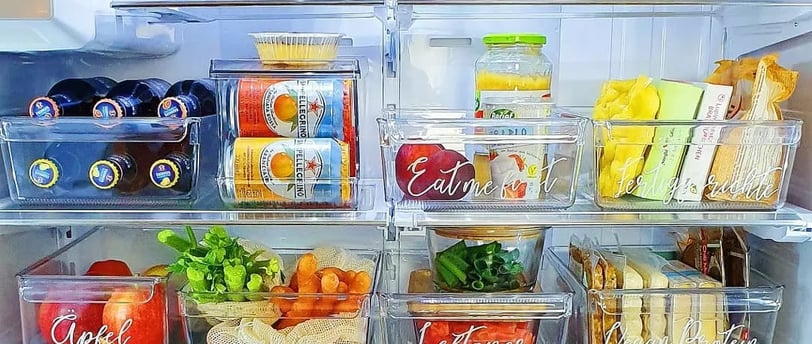Organizing your fridge and freezer can significantly improve efficiency, reduce food waste, and make it easier to find what you need. Below is a detailed outline of the best ways to keep your fridge and freezer organized, including organizing tools to use:
Fridge Organization
Dairy Section: Keep all dairy products together (milk, cheese, yogurt, butter). This area should be near the middle or upper shelves where the temperature is more stable.
Meat and Fish: Store raw meat and fish on the bottom shelf to prevent any drips from contaminating other foods. You can use a separate drawer or a dedicated shelf for meats.
Fruits and Vegetables: Designate separate drawers for fruits and vegetables, keeping them organized by type (fruits in one, vegetables in another). Use perforated produce bags or breathable containers to extend freshness.
Leftovers and Prepped Foods: Store leftovers and pre-cooked meals in clear, stackable containers so they’re visible and easy to access.
Condiments and Beverages: Designate a door shelf for sauces, condiments, and drinks, as the temperature in the door is typically the warmest.
Eggs and Other Miscellaneous Items: Keep eggs in their original carton and other small items in their own section.
Organizing Strategies
First In, First Out (FIFO): Organize items by expiration date, with older items in front so they’re used first.
Clear Containers: Use clear storage bins or glass jars so you can easily see what’s inside. This reduces clutter and makes it easier to grab what you need.
Labeling: Label containers with both the contents and the date they were placed in the fridge. This helps with tracking freshness and reducing waste.
Use Lazy Susans: These rotating trays are great for condiments, jars, and small bottles. They allow you to easily access hard-to-reach items at the back.
Baskets and Bins: Use stackable baskets for grouping similar items together. For instance, one bin could hold all snacks, another could contain drinks.
Refrigerator Organization Tools:
Fridge Bins: Stackable bins are perfect for grouping like items together. Use bins of different sizes for various food categories.
Adjustable Shelving: Adjustable shelves help to make better use of vertical space, allowing customization based on the size of items.
Produce Drawers: Special bins or organizers for fruits and vegetables that help with airflow, keeping them fresh longer.
Egg Holders: Dedicated egg containers help to keep eggs in one place, preventing them from rolling around.
Fridge Thermometer: A thermometer ensures your fridge maintains the ideal temperature (37°F to 40°F / 3°C to 4°C).
Freezer Organization:
Categorizing Items:
Frozen Meats and Fish: Use airtight bags or containers to prevent freezer burn. Organize these by type (chicken, beef, fish, etc.) and by size.
Vegetables and Fruits: Store frozen fruits and vegetables in separate sections. Keep them in labeled bags to easily identify contents.
Frozen Meals and Leftovers: Pre-portioned frozen meals should be grouped together in separate containers or labeled freezer bags.
Ice Cream and Desserts: Keep these in one area, preferably at the top or front of the freezer, so they’re easy to access.
Breads and Doughs: Store frozen bread and dough in a section dedicated to baked goods, either in bins or large freezer bags.
Bulk Items: If you buy in bulk (e.g., large bags of frozen food), divide these into smaller portions and store them in separate containers or bags.
Organizing Strategies:
Labeling: Always label freezer bags and containers with the contents and date to ensure proper rotation.
FIFO: Use the FIFO method, placing older items at the front so they are used first.
Portioning: Portion out large quantities of food before freezing, making it easier to defrost only what you need.
Stacking and Layering: Stack bags and containers by category to maximize space and keep similar items together. Use the top layers for frequently used items.
Avoid Overpacking: Don’t overcrowd the freezer. Proper air circulation helps the freezer run efficiently and ensures foods freeze evenly.
Freezer Organization Tools:
Freezer Bins: Stackable, clear bins help organize frozen items and prevent them from being jumbled. Choose bins that fit the layout of your freezer (upright vs. chest).
Labeling Stickers or Tape: Use freezer-safe labels or tape to mark items with the date and contents.
Freezer Bags: These are perfect for portioning out meat, fruits, and vegetables. Choose heavy-duty freezer bags to prevent freezer burn.
Vacuum Sealer: A vacuum sealer removes air from bags, preserving food and preventing freezer burn for a longer period.
Clear Storage Containers: Clear, stackable plastic containers can help with organizing different types of foods. Use BPA-free containers to store leftovers or frozen soups.
Wire Baskets: For chest freezers, wire baskets help group food into accessible sections, keeping everything neat and easy to access.
General Tips for Both Fridge and Freezer:
Temperature Management: Regularly check and maintain the correct temperatures in both your fridge (37°F to 40°F / 3°C to 4°C) and freezer (0°F / -18°C).
Regular Cleaning: Clean your fridge and freezer regularly to prevent spills, odors, and mold. Wipe down shelves and drawers every couple of weeks.
Defrosting: Regularly defrost your freezer (if necessary) to avoid ice buildup, which can take up space and reduce efficiency.
Inventory Tracking: Keep a written or digital inventory of what’s in your fridge and freezer. This helps you avoid buying duplicate items and track what needs to be used up.
Frequent Check-ins: Go through your fridge and freezer every week to reassess contents. It’s a good way to avoid food spoilage and waste.


